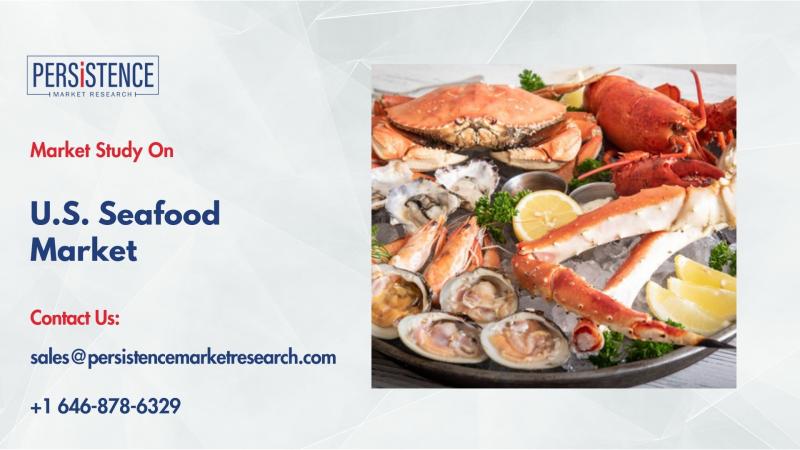Press release
U.S. Seafood Market Value to Reach $41.7 Bn by 2032 Driven by Healthy Diet and Demand
U.S. Seafood Market Size, Share, Trends, and Growth Outlook to 2032The U.S. seafood market is projected to experience robust growth in the coming years, with market size expected to rise from US$ 30.1 Bn in 2025 to US$ 41.7 Bn by 2032, expanding at a CAGR of 4.8% during 2025-2032. Growing health awareness, demand for protein-rich diets, rising imports of exotic seafood, and sustainable aquaculture practices are fueling this steady growth trajectory. The industry is also influenced by innovations in frozen seafood, ready-to-eat (RTE) meals, and value-added products, making seafood more accessible to the wider U.S. population.
Within the market, fish continues to dominate as the leading product segment due to its high protein content, versatility in cuisines, and rising popularity among health-conscious consumers. Regionally, the West Coast leads the U.S. seafood market, driven by its extensive fishing industries, strong aquaculture production, and higher seafood consumption levels compared to inland states. Additionally, coastal cities such as Seattle, Los Angeles, and San Francisco remain major consumption and distribution hubs, supported by both domestic catches and international imports.
Get a Sample PDF Brochure of the Report (Use Corporate Email ID for a Quick Response): https://www.persistencemarketresearch.com/samples/35226
Key Highlights from the Report
• The U.S. seafood market is forecasted to grow at a CAGR of 4.8% between 2025 and 2032.
• Rising consumer demand for healthy, protein-rich foods is a major growth driver.
• Fish remains the leading product segment due to versatility and health benefits.
• West Coast emerges as the largest regional market, led by high consumption levels.
• Sustainable aquaculture practices are reshaping long-term industry strategies.
• Frozen and ready-to-cook seafood products are witnessing accelerated adoption.
Market Segmentation
The U.S. seafood market is segmented across multiple product categories, catering to diverse consumer preferences and dietary habits. By product type, fish dominates the segment owing to its widespread availability and health benefits. Salmon, cod, tuna, and tilapia are among the most preferred fish varieties, driven by strong consumer demand in retail and foodservice sectors. Crustaceans, including shrimp, crab, and lobster, represent another high-value segment. Shrimp, in particular, has seen rising consumption due to its convenience and suitability for quick meals. Mollusks such as oysters, mussels, and clams are popular in niche markets, especially in fine dining and regional cuisines.
In terms of end-users, the retail sector accounts for a significant portion of seafood sales, largely influenced by the growing popularity of packaged, frozen, and ready-to-cook seafood. Supermarkets, hypermarkets, and specialty seafood outlets are expanding their assortments to include more premium and sustainable options. The foodservice industry, including restaurants, quick-service chains, and hotels, also plays a critical role in driving seafood consumption. With the growing demand for sushi, poke bowls, and seafood-based gourmet meals, foodservice providers are increasingly focusing on high-quality imports and locally sourced seafood to meet diverse customer preferences.
Value-added products, including breaded, marinated, and pre-seasoned seafood, are emerging as a fast-growing segment, as consumers seek convenience without compromising on taste and nutrition. Additionally, the rise of online seafood delivery platforms is expanding market reach, catering to both urban and rural consumers with fresh and frozen options.
Regional Insights
The U.S. seafood market displays strong regional variation, with coastal regions continuing to dominate consumption and production. The West Coast, led by California, Oregon, and Washington, is the largest regional market, benefiting from robust aquaculture, diverse seafood offerings, and high per capita consumption. The Pacific Ocean's rich resources, coupled with proximity to Asian export markets, further strengthen the region's dominance.
The Northeast region, particularly states like Maine and Massachusetts, is well known for lobster, clams, and other shellfish. This region benefits from its established fishing traditions and high demand from both domestic and international buyers. The Southeast, including Florida and Louisiana, is another critical region, driven by shrimp farming and seafood-based cuisines deeply integrated into local culture.
Inland regions of the Midwest are witnessing growing demand due to improved cold chain logistics, expanding supermarket offerings, and the popularity of frozen seafood products. This highlights the broadening reach of the seafood industry beyond coastal areas, making seafood accessible to a larger share of U.S. consumers.
Market Drivers
Several key drivers are fueling the expansion of the U.S. seafood market. One of the most important is the growing consumer preference for healthy, protein-rich, and low-fat diets. Seafood, particularly fish, is rich in omega-3 fatty acids, which support cardiovascular health, brain function, and overall well-being. As consumers become more health-conscious, seafood consumption is steadily increasing.
Another strong driver is the rise of aquaculture and sustainable fishing practices. With concerns around overfishing and environmental sustainability, aquaculture is emerging as a reliable source of seafood supply. U.S. aquaculture production has expanded significantly, ensuring consistent availability of salmon, catfish, and tilapia.
Convenience-driven lifestyles are also reshaping the market. Consumers increasingly prefer frozen, ready-to-cook, and packaged seafood products, which are widely available across supermarkets and online platforms. Growing multiculturalism in the U.S. has also expanded seafood consumption, as Asian, Mediterranean, and Latin cuisines introduce more consumers to seafood-rich diets.
Market Restraints
Despite positive growth, the U.S. seafood market faces several challenges. Price volatility remains a major restraint, influenced by fluctuating fuel costs, global trade disruptions, and changes in supply-demand dynamics. Import dependence for certain species, especially shrimp and tuna, exposes the market to international risks.
Environmental concerns also pose challenges, as overfishing, climate change, and pollution threaten natural seafood resources. Regulatory restrictions around sustainable fishing practices may limit supply in certain categories. Moreover, consumer hesitancy around seafood freshness, storage, and safety issues sometimes acts as a barrier to adoption, particularly among inland consumers less familiar with seafood preparation.
Market Opportunities
The U.S. seafood industry has significant opportunities to expand further. One key opportunity lies in value-added and premium seafood products, as consumers increasingly demand convenience and high-quality offerings. Brands that invest in ready-to-eat, marinated, and seasoned seafood will capture strong market interest.
Sustainability-focused initiatives present another opportunity. With consumers prioritizing eco-friendly purchases, seafood suppliers that embrace traceability, eco-certifications, and sustainable sourcing practices can strengthen brand loyalty.
The rise of e-commerce and direct-to-consumer seafood delivery platforms also offers a lucrative growth path. Online platforms enable fresh and frozen seafood to reach a broader demographic, especially in non-coastal states. Additionally, the growing demand for plant-based seafood alternatives opens up new avenues for innovation and product diversification.
Reasons to Buy the Report
1. Gain an in-depth understanding of the U.S. seafood market's size, trends, and future outlook.
2. Identify key growth drivers, challenges, and opportunities shaping the industry.
3. Analyze regional insights and consumer behavior to refine market entry strategies.
4. Access competitive intelligence on leading players and recent market developments.
5. Leverage reliable market forecasts to make informed investment and business decisions.
Frequently Asked Questions (FAQs)
How Big is the Market?
Who are the Key Players in the Global Market for Seafood?
What is the Projected Growth Rate of the Market?
What is the Market Forecast for 2032?
Which Region is Estimated to Dominate the Industry through the Forecast Period?
Company Insights
Key players in the U.S. seafood market include:
• Trident Seafoods Corporation
• High Liner Foods Inc.
• Clearwater Seafoods
• Pacific Seafood Group
• Thai Union Group PCL
• Bumble Bee Foods LLC
• Mowi ASA
• Cooke Aquaculture Inc.
• Nippon Suisan Kaisha, Ltd.
• Maruha Nichiro Corporation
Recent Developments:
• In 2024, Trident Seafoods announced an expansion of its value-added frozen seafood product line targeting health-conscious and convenience-seeking U.S. consumers.
• High Liner Foods partnered with sustainability organizations in 2025 to strengthen traceability across its North American seafood supply chain.
Conclusion
The U.S. seafood market is poised for sustained growth, supported by health-driven consumer preferences, sustainable aquaculture, and rising demand for convenient, value-added seafood products. With a projected CAGR of 4.8% between 2025 and 2032, the industry is set to expand from US$ 30.1 Bn to US$ 41.7 Bn, creating substantial opportunities for producers, distributors, and retailers. However, addressing challenges such as price volatility, environmental sustainability, and consumer awareness will be critical for long-term success. Companies that focus on innovation, sustainability, and digital sales channels are expected to emerge as leaders in shaping the future of the U.S. seafood industry.
Explore the Latest Trending Research Reports
Black Pepper Market Size: https://www.persistencemarketresearch.com/market-research/black-pepper-market.asp
Soups And Broths Market Size: https://www.persistencemarketresearch.com/market-research/soups-and-broths-market.asp
Food Ingredients Market Size: https://www.persistencemarketresearch.com/market-research/food-ingredients-market.asp
About Persistence Market Research:
At Persistence Market Research, we specialize in creating research studies that serve as strategic tools for driving business growth. Established as a proprietary firm in 2012, we have evolved into a registered company in England and Wales in 2023 under the name Persistence Research & Consultancy Services Ltd. With a solid foundation, we have completed over 3600 custom and syndicate market research projects, and delivered more than 2700 projects for other leading market research companies' clients.
Our approach combines traditional market research methods with modern tools to offer comprehensive research solutions. With a decade of experience, we pride ourselves on deriving actionable insights from data to help businesses stay ahead of the competition. Our client base spans multinational corporations, leading consulting firms, investment funds, and government departments. A significant portion of our sales comes from repeat clients, a testament to the value and trust we've built over the years.
Contact Us:
Persistence Market Research
G04 Golden Mile House, Clayponds Lane
Brentford, London, TW8 0GU UK
USA Phone: +1 646-878-6329
UK Phone: +44 203-837-5656
Email: sales@persistencemarketresearch.com
Web: https://www.persistencemarketresearch.com
This release was published on openPR.
Permanent link to this press release:
Copy
Please set a link in the press area of your homepage to this press release on openPR. openPR disclaims liability for any content contained in this release.
You can edit or delete your press release U.S. Seafood Market Value to Reach $41.7 Bn by 2032 Driven by Healthy Diet and Demand here
News-ID: 4159387 • Views: …
More Releases from Persistence Market Research

Corn Starch Derivatives Market Value to Reach $27.9 Bn by 2032, Driven by Food & …
Overview of the Market
The global corn starch derivatives market is on a strong growth trajectory, projected to expand from US$15.8 Bn in 2025 to US$27.9 Bn by 2032, recording a healthy CAGR of 8.5% during 2025-2032. Corn starch derivatives are obtained through enzymatic and chemical processes and are widely used across food & beverages, pharmaceuticals, textiles, paper, and personal care industries. Their ability to enhance texture, improve stability, and serve…

U.S. Egg Replacement Market to Reach $421.8 Mn by 2032, Driven by Rising Vegan & …
Overview of the Market
The U.S. egg replacement market has been witnessing steady growth, driven by rising consumer awareness about health, dietary restrictions, and ethical considerations. Egg replacements, which include plant-based substitutes such as mung bean, chickpea, flaxseed, and commercial egg replacers, have become increasingly popular among vegan, vegetarian, and allergy-conscious populations. The market is projected to rise from US$260.2 million in 2025 to US$421.8 million by 2032, recording a CAGR…

Synthetic Beta-Carotene Market to Reach US$ 641.8 Mn by 2032, Driven by Rising H …
Overview of the Market
The global synthetic beta-carotene market is projected to witness substantial growth over the forecast period, driven by increasing demand across food, feed, and pharmaceutical industries. Valued at US$ 435.4 Million in 2025, the market is expected to expand at a CAGR of 5.7%, reaching a valuation of US$ 641.8 Million by 2032. Synthetic beta-carotene, widely used as a colorant and vitamin A precursor, has become indispensable in…

Europe Banana Flour Market to Reach US$ 498.3 Mn by 2032, Driven by Health & Glu …
Overview of the Market
The Europe banana flour market has witnessed a consistent growth trajectory over the past few years. Expanding at a CAGR of 4.8% from 2019 to 2024, the market reached a valuation of US$ 324.9 million in 2025. According to Persistence Market Research, the market is projected to continue its robust growth, recording a CAGR of 6.3% and reaching an estimated value of US$ 498.3 million by the…
More Releases for Seafood
Tasman Star Seafood Market Launches Signature Seafood Platters
Image: https://www.globalnewslines.com/uploads/2025/08/1754300082.jpg
The renowned seafood business has introduced two premium platters made in house with fresh products.
Gold Coast, QLD - August 4, 2025 - Tasman Star Seafood Market, known for its premium local seafood offerings, has launched a signature range of seafood platters available both in store and online daily from 10:30AM. These beautifully curated platters feature high-quality, fresh sashimi and sushi selections, expertly prepared by the market's in-house Japanese chefs.
Image:…
Frozen Seafood Market Value Projected to Expand by 2025 | Seven Seas, IFC Frozen …
The easy accessibility and availability of various varieties of seafood under one roof through establishment of large retail chains especially in the developing countries helps propel the market expansion. However, overfishing has become a great cause of concern not only to the fisheries but also the environment. Overexploitation could lead to less availability of fish, which in turn increases the prices of frozen seafood, ultimately hampering the market growth.
Request…
Frozen Fish and Seafood Market Future Growth Outlook 2021-2027 | Austevoll Seafo …
“Frozen Fish and Seafood Market is growing at a 9.97% CAGR during the forecast period 2020-2026. The increasing interest of the individuals in this industry is that the major reason for the expansion of this market”.
Frozen fish and seafood are stored in vacuum-tight compartments and at freezing temperatures to minimize the growth of unwanted microbes and to ensure fresh and high quality products for the end user.
The frozen fish…
Seafood Market Excellent Growth 2021 Top Key Players | Pacific Seafood, Kangami …
Seafood Market Overview:
The market research report on the Global Seafood Market offered by Straits Research, analyses the major opportunities, CAGR, yearly growth rates to help the readers to understand the qualitative and quantitative aspects of the Global Seafood Market. The competition landscape, company overview, financials, recent developments and long-term investments related to the Global Seafood Market are mentioned in this report. Various parameters have been studied while estimating the market size. The revenue…
Processed Seafood & Seafood Processing Equipment Market
According to a new market research report published by Global Market Estimates, the Global Processed Seafood & Seafood Processing Equipment Market is expected to grow at a CAGR of 5.85% during the forecast period, to reach USD 2.21 Billion by 2026. The demand for processed seafood & seafood processing equipment is high due to the increasing consumption of seafood across the globe.
Browse 164 Market Data Tables and 129 Figures spread…
Global Frozen Seafood Market 2020 Future Trends - AquaChile, Austevoll Seafood, …
The “Frozen Seafood Market By Product Type (Fish, Crustaceans, Shellfish, Molluscs, And Others) and By Distribution Channel (Supermarket & Hypermarket, Convenience Stores, Online Stores, And Others): Global Industry Perspective, Comprehensive Analysis And Fore” A fundamental outline of the Frozen Seafood niche is presented by the Frozen Seafood report that entails definitions, classifications, applications together with industry chain framework. The Frozen Seafood report provides a far-reaching evaluation of necessary market dynamics…
